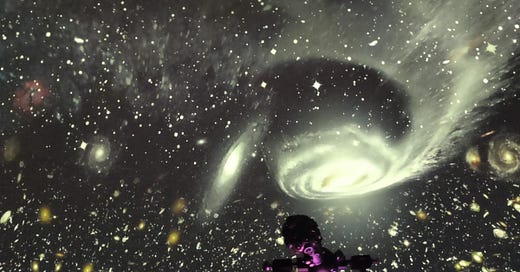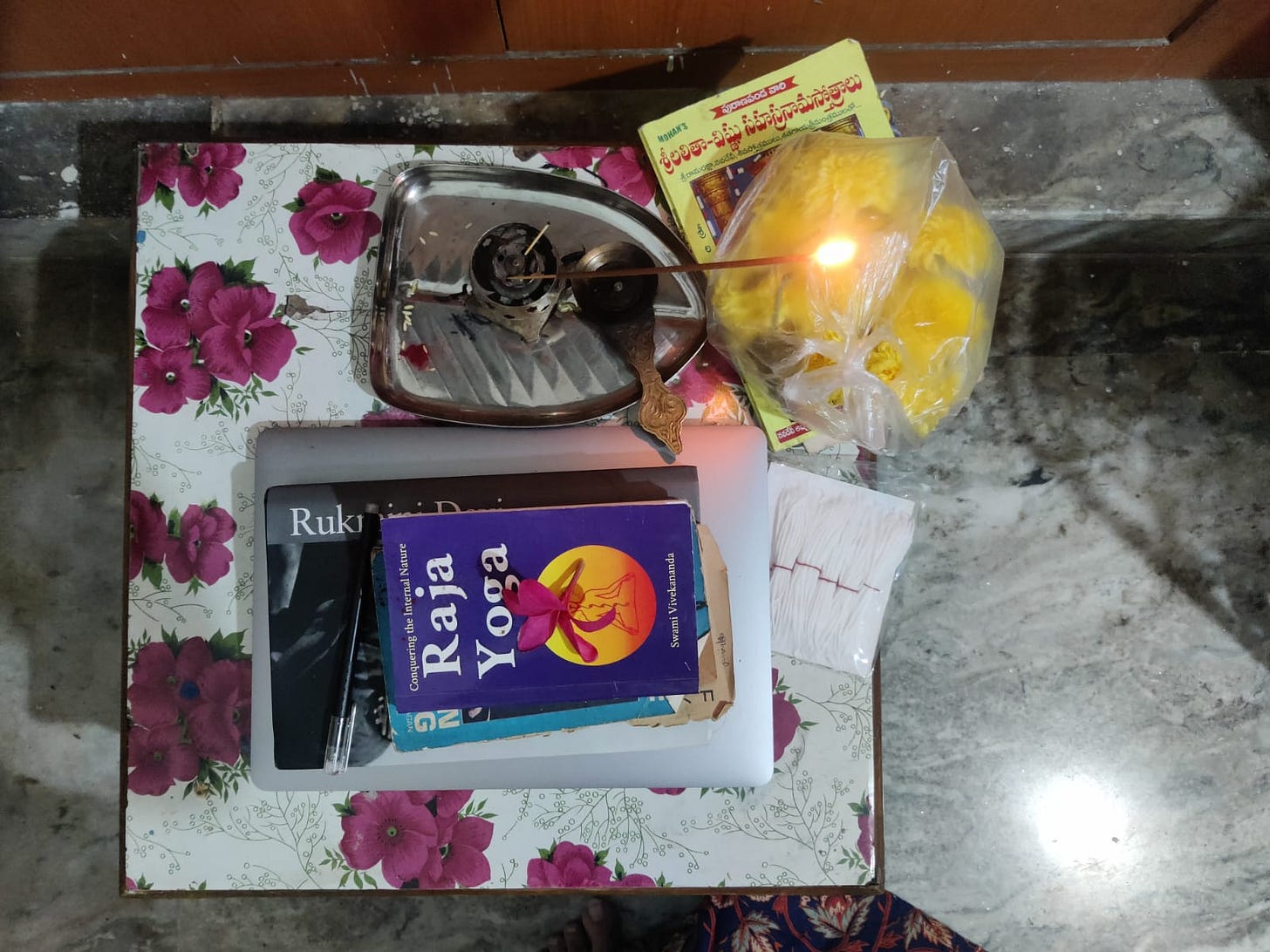How are you shining this week, my sun and stars? I’ve been trying to establish structure in my creative practice by releasing an article every week. But this week, in honor of Diwali, the festival of lights, I’m sharing a special mid-week piece!
Last week, I attended a lecture on Gravity at the Nehru Planetarium in Bengaluru.
As a poet, I am hard-wired to search for metaphor in the external world. I couldn’t help but wonder whether we can find lessons on human nature in the journey of cosmic objects.
Could it be possible at all that the journeys of objects at different scales tell us stories about ourselves?
A star is born
Stars are born from vast clouds of dust and gas called nebulae. Soon parts of a nebula become dense enough to collapse under their own gravity, often triggered by nearby disturbances. As the gas and dust collapse, they gather mass and heat up. When the core temperature blows up, nuclear fusion ignites, converting hydrogen into helium. This fusion produces immense energy, countering the force of gravity, and the star becomes stable and shines brightly.
Human minds are born in the dust of our own ignorance. As our thoughts lack clarity and focus, we slowly lose to the gravity of our own fear and anxieties, often triggered by the external world. At the cusp of an explosion, we set out on an inner journey which takes us through an inner process of sense-making. This creates immense energy, fights the gravity of our fears and anxieties, as we shine our light brightly and warm the hearts around us as human stars.
Fighting gravity
Every star, regardless of size or brilliance, is constantly burning its hydrogen fuel. This process of nuclear fusion generates immense energy, producing the star’s heat and light while creating outward pressure that counteracts gravity’s inward pull. This balance is vital—it keeps the star from collapsing under its own weight.
Ever since the human star is born, she is in the process of fighting the gravity of self-doubt and ignorance. She must create an inner pressure to fight ignorance by keeping her inner core hot. She must identify what truly fuels the spirit by participating in an inner process of gathering inspiration, and making sense of it by developing the human faculties to embody it into knowledge.
The role of mass
As long as the star has enough hydrogen to fuse, it remains stable, its outward pressure balanced by gravity's inward pull. But hydrogen is a finite fuel source, and over millions to billions of years, the star’s hydrogen supply is slowly depleted, and burns out.
For stars similar in mass to our Sun, this means shedding their outer layers, forming a planetary nebula, while the core collapses into a white dwarf. For more massive stars, this leads to a powerful supernova explosion, leaving behind a dense neutron star or, in the most massive cases, collapsing into a black hole.
As human stars continue on their spiritual journey, or their life path, they eventually reach an end when their fuel source runs out.
This may be a physical death such as when a wonderful creative dies. It may also be a spiritual death, when a person, who is alive, has lost their inner direction and set out on a path that does not feed their spirit.
How a stars death affects other celestial bodies depends on the role of mass which, to me, is the human ego. A human star, having a low mass, sheds her outer layers, all the layers of her personality which are not essential to maintaining her inner light. Such a star, like the sun, can provide sustenance for planets with various life forms. When such stars die, they become planetary nebulae, inspiring others, leading to more stars being born.
When it is a spiritual death, such as when people having a much larger ego lose their inner direction, the star collapses under its own gravity, and succumbs to its mass, becoming a dense neutron star or, even, a black hole.
When a human star becomes a neutron star, she becomes so dense as to become impenetrable. Such a person has lost her light completely to a deep depression, under the extreme gravity of her fears and anxieties.
When a human star becomes a black hole, he becomes hungry for another’s light, creating destruction in his wake. Such human black holes can be hard to spot based on any outer attributes, but can surely be spotted by the effect on those around them losing their light.
Which stage of the inner celestial journey do you relate to?
This brings me to my announcement:
I have officially started writing my first book(s) today!
“Mirrors & Windows” is a book (series) of meditations on history, mythology, astronomy, nature, music and fine art. Through the language of poetry, I write about awe-inspiring moments that lead us to our creativity. Such moments dwarf the human ability to comprehend space and time — inspiring us to self-discover, moving us to self-express and empowering us to achieve self-mastery. Within the pages of my book, I hope you find mirrors to your truest desires and windows that open to your deepest expressions!
This book has been born from my conviction in the role of fine art and spirituality in modern society. The role of fine art and spirituality is not immediately palpable. But it elevates and empowers individuals and nations such that the impact is felt over several generations.
In the age of AI, I truly believe that we must lean into our natural creativity because it comes from something beyond us, and can’t be tapped by a machine. Hence, I want to lean into my artistic creativity, empathy, idealism — which is personally rewarding but also urgently needed in today’s world.
I am giving myself one year to finish working on my first book. I plan to keep to myself a lot while I am pregnant with this book and labouring over it in private. But I will be documenting my creative process including building my art studio, book binding the art and words for the book on this blog :)
I am excited about it!!!
Currently inspired by:
Raja Yoga by Swami Vivekananda
I have been illuminated by this book, which was written by Swami Vivekananda in 1896. It has also been inspiring to learn that Swami Vivekananda had a leaning towards fine arts when he was young. I understand now that the purpose of fine arts is not utilitarian but simply to elevate the human spirit. It has made my conviction stronger to pursue a parallel career in writing and fine arts.Rukmini Devi Arundale by Leela Samson
Rukmini Arundale was born to a progressive Indian family in 1904. Her father was an intellectual who was introduced to Theosophical Society, which borrowed its philosophy from eastern religions. Thus, Rukmini Devi grew up around spiritually-inclined individuals near the headquarters of Theosophical Society in Adyar, Chennai. She received the mentorship of powerful women figures such as Annie Besant and Maria Montessori. At 16, she married George Arundale, who was then 42, which would be shocking even in these days. Through their travels, she was first introduced to contemporary ballet at 24, and later found her calling in re-discovering Indian Classical dance form, which was relegated to a lower status in society at that time. She was also a deeply altruistic human being who was instrumental for the legislation for the Prevention of Cruelty to Animals Act in India. She was also committed to the causes of vegetarianism and simplicity. She was the first Indian woman to be nominated in Rajya Sabha, which she declined because she continued to work in Kalakshetra School of Dance, Adyar, Chennai. A truly inspiring lady!





